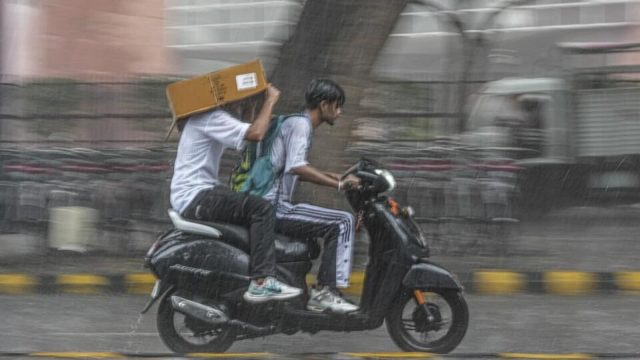More than 1.6 million people have been displaced in unabated flooding in the northeast, with Assam and Manipur the hardest hit by incessant rainfall. According to reports, the death toll in these two states reached 48 as of 3 July.
The situation prompted the India Meteorological Department (IMD) to issue district-wise red alerts for all northeastern states on Thursday, especially for areas located near the Brahmaputra river and its tributaries.
The weather bureau said two cyclonic circulations over northeast Rajasthan and a trough running from northeast Rajasthan to Bangladesh and over west Jharkhand may cause widespread rainfall accompanied by thunderstorm and lightning over east and northeast India, including Gangetic West Bengal, Andaman & Nicobar Islands, Jharkhand, Odisha, Bihar, Sub-Himalayan West Bengal, Sikkim, Arunachal Pradesh, Nagaland, Manipur, Mizoram, Tripura, Assam and Meghalaya during the next four-five days.
Heavy rains on Thursday and Friday
Extremely heavy rainfall is expected over Arunachal Pradesh, Assam and Meghalaya on Thursday and Friday.
With heavy rain and overflowing rivers, Assam and Arunachal Pradesh have been reeling under severe flooding and the state administrations are bracing themselves for a deterioration in the situation over the next few days.
This has prompted the authorities in Assam to evacuate thousands to relief camps due to extensive damage to homes and infrastructure.
The flood situation in Assam further deteriorated with over 1.65 million population affected in 29 districts with the major rivers flowing above the danger level across the state on 4 July, officials said. Eight people died from drowning.
The worst affected districts in Assam are Nagaon and Darrang in central Assam and Karimganj in the Barak Valley.
Meanwhile, 17 wild animals, including a rhino calf and hog deer, drowned in Kaziranga National Park, while 72 were rescued by the forest authorities; another 32 wild animals are currently under treatment and 25 others were released. The flood situation in Assam’s Kaziranga National Park is still grim, as 173 forest camps in the park are still reeling under the flood situation, according to media reports.
“The park authorities and forest department have rescued 55 Hog Deer, two otters (infants), two Sambar, two Scops Owls, one rhino calf, one Indian Hare, one Jungle cat, etc,” Sonali Ghosh, Field Director of Kaziranga National Park, told ANI.
On the other hand, incessant rainfall resulted in flooding at several places in Manipur’s Imphal West and Imphal East districts, after two major rivers breached embankments, officials said prompting closure of schools in the state till 4 July.
Heavy weather in North-west also
The weather bureau also sees very heavy rainfall over northwest India, including Punjab, Haryana, Chandigarh and Uttar Pradesh for the next four-five days, but Delhi will see no lashes.
While eastern states such as Jharkhand, Odisha and Bihar are likely to experience a similar weather condition, northeast India, including Arunachal Pradesh, Nagaland, Manipur, Mizoram, Tripura and Meghalaya could see extremely heavy rainfall during the same period, it said.
“As monsoon trough is near normal position at mean sea level and a cyclonic circulation laying over southeast Pakistan, widespread light to moderate rainfall accompanied by thunderstorm and lightning is likely over northwest and central India during the next five days,” the India Meteorological Department (IMD) said in a statement.
Heavy rainfall is seen over Jammu, Kashmir, Ladakh, Himachal Pradesh, Uttarakhand, Punjab, Haryana, Chandigarh, Uttar Pradesh, Rajasthan, Vidarbha, Madhya Pradesh and Chhattisgarh during this period.
No rain in Delhi
But no rain is expected in Delhi, IMD said after missing its projection for the national capital earlier this week.
IMD’s “significant rainfall” forecast for Delhi on Monday forecast turned out to be inaccurate as the national capital remained bone dry and experienced a hot day because of high humidity.
The highest temperature recorded in Delhi was 36°c though the heat index or real feel temperature was 47°c as the humidity level was between 59-82%. The weather bureau revised its forecast for Delhi twice that day.
At 9 am, the colour coded alert, which indicates the intensity of weather events, was dropped to ‘yellow’ with light to moderate rain expected throughout the remaining day. This was revised to orange at around 1:30 pm with moderate to heavy rainfall forecast.
On Tuesday, the southwest monsoon, which arrived in Kerala two days earlier than usual on 30 May, covered the entire country six days ahead of the normal date of 8 July.
It progressed normally up to Maharashtra but lost momentum after 9 June—two days earlier than the usual date, prolonging the wait for rains in West Bengal, Odisha, Jharkhand, Bihar, Chhattisgarh, Madhya Pradesh and Uttar Pradesh, which were reeling from a heatwave.
The country recorded 16 days of below-normal rainfall from 11 June to 27 June, registering overall below-normal rainfall at 147.2 mm in the month against a normal of 165.3 mm. This was the seventh lowest on record since 2001.
June rainfall accounts for 15% of the total precipitation of 87 cm recorded during the country’s four-month monsoon season.
The IMD on 1 July said India could experience above-normal rainfall in July, with heavy rains potentially leading to floods in the western Himalayan states and river basins in the central parts of the country.
The national rainfall deficiency came down to 4% since the beginning of the four-month (June-September) monsoon season.



